University Name: Domestic Violence on BAME Women in Coventry
VerifiedAdded on 2021/04/17
|25
|7066
|53
Report
AI Summary
This report provides a thorough literature review on the prevalence and impact of domestic violence on Black, Asian, and minority ethnic (BAME) women, particularly in Coventry, UK. The research aims to analyze the root causes of domestic violence within the BAME community, including social inequality, cultural factors, language barriers, and economic disparities. It explores the various consequences of domestic violence on the women's physical and mental health, as well as their access to support services. The review delves into the situation of BAME women in the UK, examining statistics on domestic violence, government initiatives, and the role of social constructionism theory in perpetuating violence. It also identifies research gaps and discusses the need for improved support and intervention services to address the challenges faced by BAME women experiencing domestic violence. The report highlights the importance of understanding the complex interplay of social, cultural, and economic factors that contribute to domestic violence within this community.
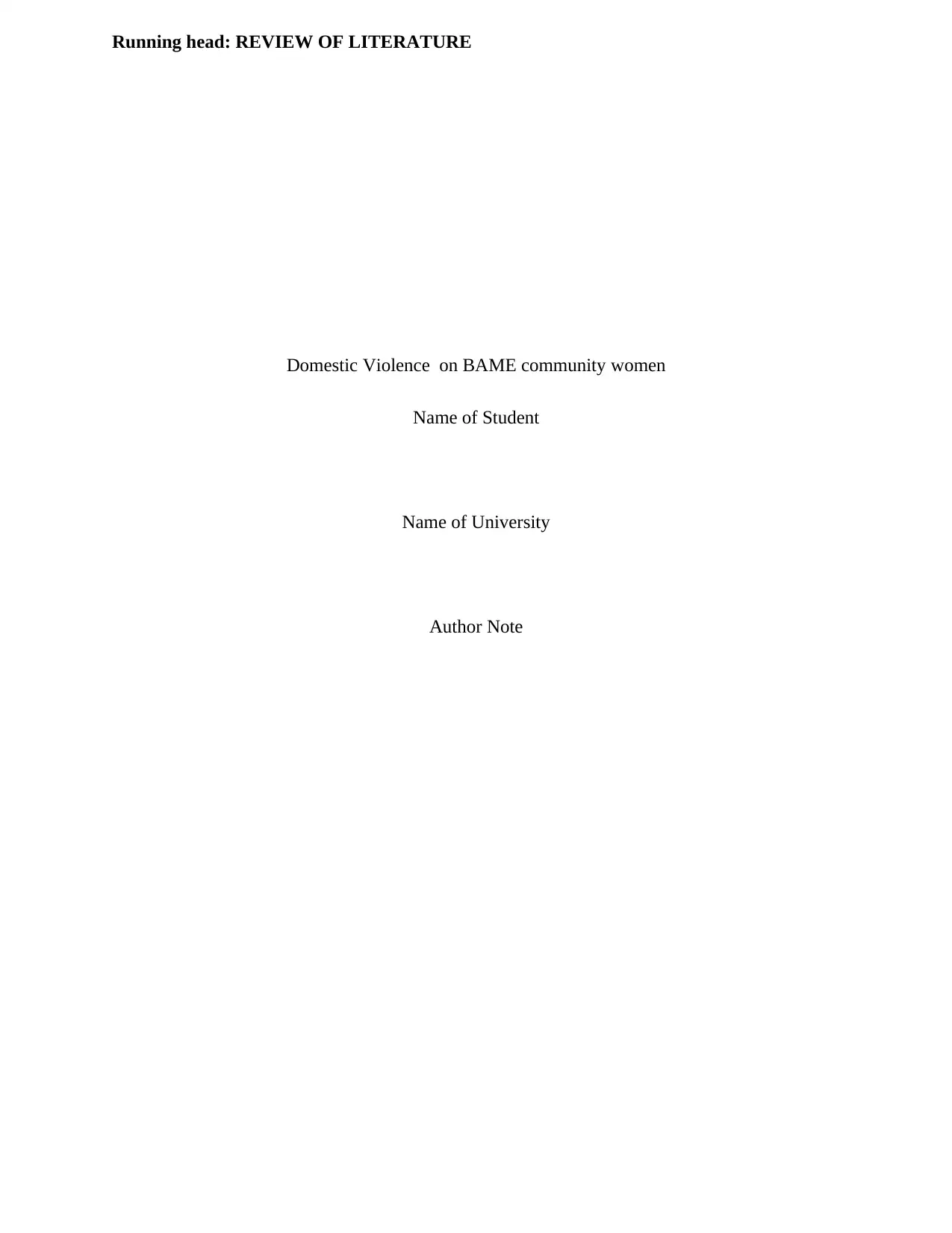
Running head: REVIEW OF LITERATURE
Domestic Violence on BAME community women
Name of Student
Name of University
Author Note
Domestic Violence on BAME community women
Name of Student
Name of University
Author Note
Paraphrase This Document
Need a fresh take? Get an instant paraphrase of this document with our AI Paraphraser
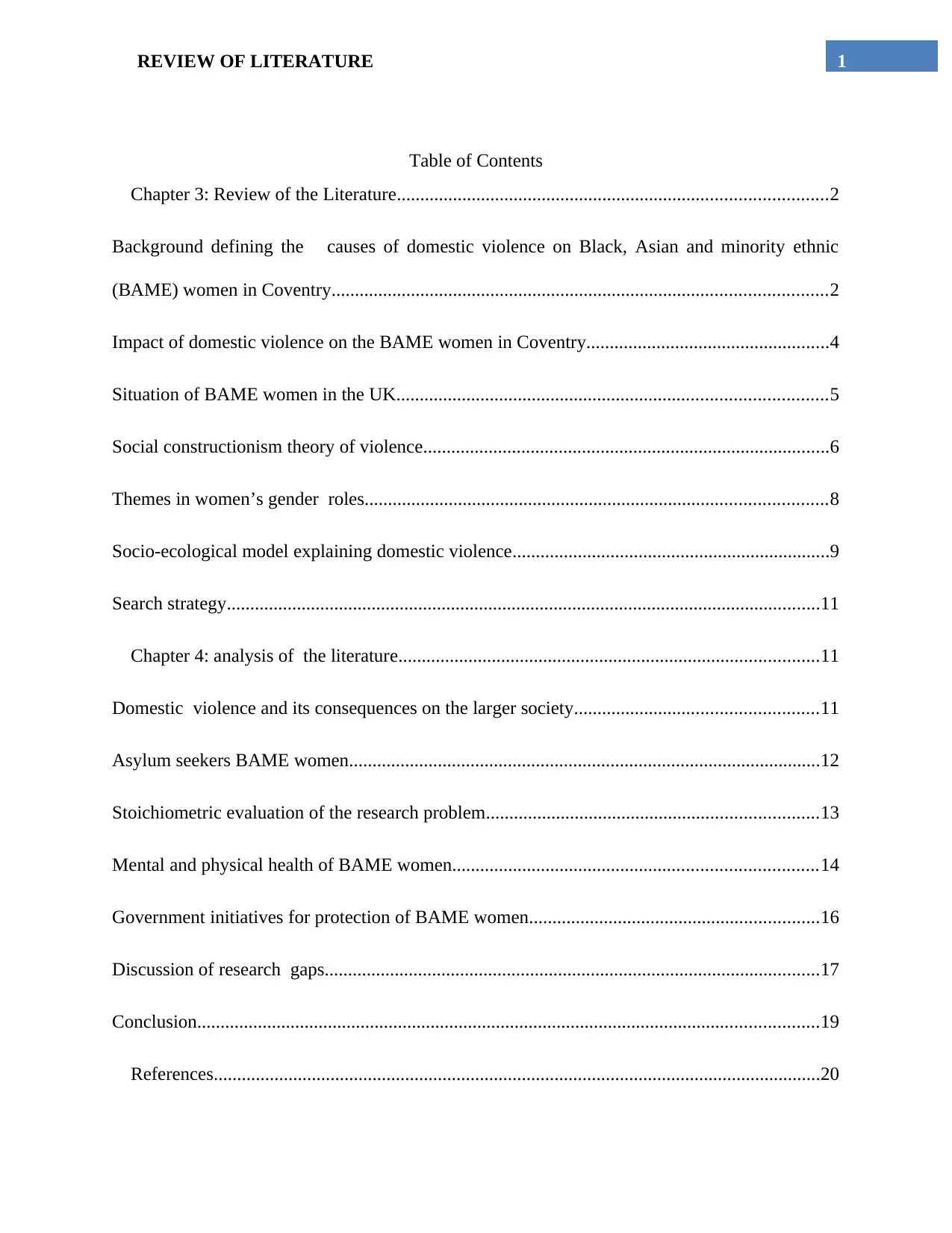
1REVIEW OF LITERATURE
Table of Contents
Chapter 3: Review of the Literature............................................................................................2
Background defining the causes of domestic violence on Black, Asian and minority ethnic
(BAME) women in Coventry..........................................................................................................2
Impact of domestic violence on the BAME women in Coventry....................................................4
Situation of BAME women in the UK............................................................................................5
Social constructionism theory of violence.......................................................................................6
Themes in women’s gender roles...................................................................................................8
Socio-ecological model explaining domestic violence....................................................................9
Search strategy...............................................................................................................................11
Chapter 4: analysis of the literature..........................................................................................11
Domestic violence and its consequences on the larger society....................................................11
Asylum seekers BAME women.....................................................................................................12
Stoichiometric evaluation of the research problem.......................................................................13
Mental and physical health of BAME women..............................................................................14
Government initiatives for protection of BAME women..............................................................16
Discussion of research gaps..........................................................................................................17
Conclusion.....................................................................................................................................19
References..................................................................................................................................20
Table of Contents
Chapter 3: Review of the Literature............................................................................................2
Background defining the causes of domestic violence on Black, Asian and minority ethnic
(BAME) women in Coventry..........................................................................................................2
Impact of domestic violence on the BAME women in Coventry....................................................4
Situation of BAME women in the UK............................................................................................5
Social constructionism theory of violence.......................................................................................6
Themes in women’s gender roles...................................................................................................8
Socio-ecological model explaining domestic violence....................................................................9
Search strategy...............................................................................................................................11
Chapter 4: analysis of the literature..........................................................................................11
Domestic violence and its consequences on the larger society....................................................11
Asylum seekers BAME women.....................................................................................................12
Stoichiometric evaluation of the research problem.......................................................................13
Mental and physical health of BAME women..............................................................................14
Government initiatives for protection of BAME women..............................................................16
Discussion of research gaps..........................................................................................................17
Conclusion.....................................................................................................................................19
References..................................................................................................................................20
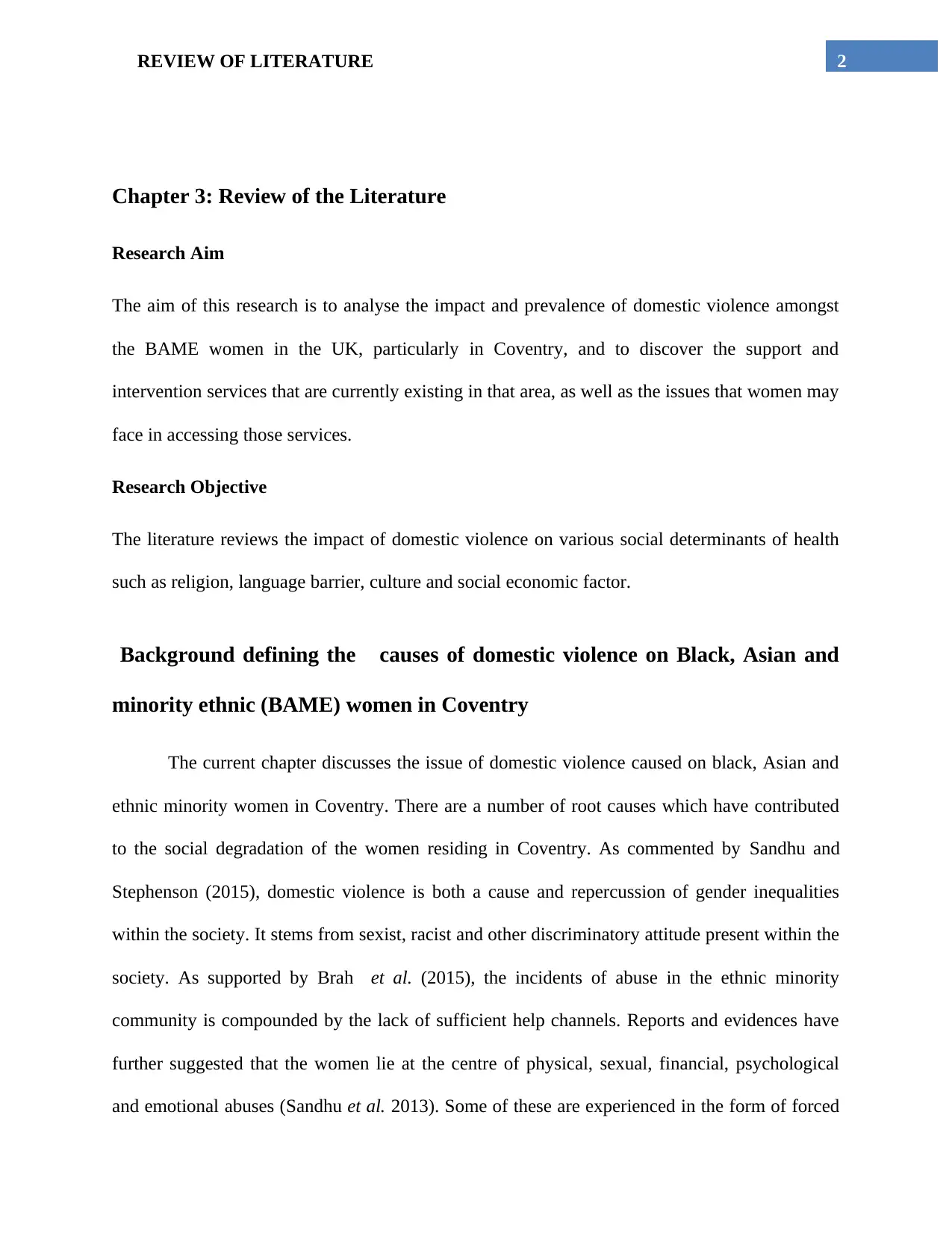
2REVIEW OF LITERATURE
Chapter 3: Review of the Literature
Research Aim
The aim of this research is to analyse the impact and prevalence of domestic violence amongst
the BAME women in the UK, particularly in Coventry, and to discover the support and
intervention services that are currently existing in that area, as well as the issues that women may
face in accessing those services.
Research Objective
The literature reviews the impact of domestic violence on various social determinants of health
such as religion, language barrier, culture and social economic factor.
Background defining the causes of domestic violence on Black, Asian and
minority ethnic (BAME) women in Coventry
The current chapter discusses the issue of domestic violence caused on black, Asian and
ethnic minority women in Coventry. There are a number of root causes which have contributed
to the social degradation of the women residing in Coventry. As commented by Sandhu and
Stephenson (2015), domestic violence is both a cause and repercussion of gender inequalities
within the society. It stems from sexist, racist and other discriminatory attitude present within the
society. As supported by Brah et al. (2015), the incidents of abuse in the ethnic minority
community is compounded by the lack of sufficient help channels. Reports and evidences have
further suggested that the women lie at the centre of physical, sexual, financial, psychological
and emotional abuses (Sandhu et al. 2013). Some of these are experienced in the form of forced
Chapter 3: Review of the Literature
Research Aim
The aim of this research is to analyse the impact and prevalence of domestic violence amongst
the BAME women in the UK, particularly in Coventry, and to discover the support and
intervention services that are currently existing in that area, as well as the issues that women may
face in accessing those services.
Research Objective
The literature reviews the impact of domestic violence on various social determinants of health
such as religion, language barrier, culture and social economic factor.
Background defining the causes of domestic violence on Black, Asian and
minority ethnic (BAME) women in Coventry
The current chapter discusses the issue of domestic violence caused on black, Asian and
ethnic minority women in Coventry. There are a number of root causes which have contributed
to the social degradation of the women residing in Coventry. As commented by Sandhu and
Stephenson (2015), domestic violence is both a cause and repercussion of gender inequalities
within the society. It stems from sexist, racist and other discriminatory attitude present within the
society. As supported by Brah et al. (2015), the incidents of abuse in the ethnic minority
community is compounded by the lack of sufficient help channels. Reports and evidences have
further suggested that the women lie at the centre of physical, sexual, financial, psychological
and emotional abuses (Sandhu et al. 2013). Some of these are experienced in the form of forced
⊘ This is a preview!⊘
Do you want full access?
Subscribe today to unlock all pages.

Trusted by 1+ million students worldwide
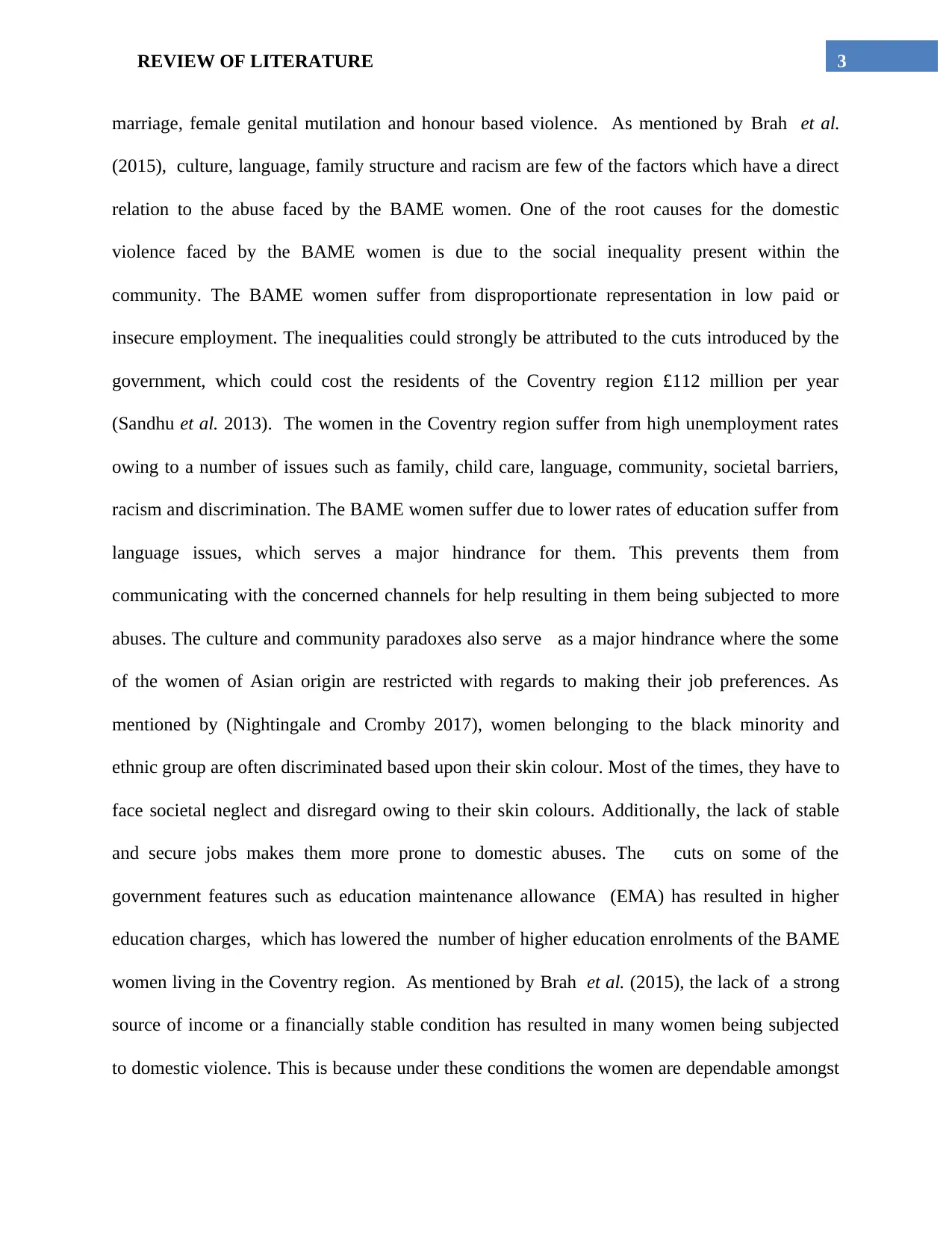
3REVIEW OF LITERATURE
marriage, female genital mutilation and honour based violence. As mentioned by Brah et al.
(2015), culture, language, family structure and racism are few of the factors which have a direct
relation to the abuse faced by the BAME women. One of the root causes for the domestic
violence faced by the BAME women is due to the social inequality present within the
community. The BAME women suffer from disproportionate representation in low paid or
insecure employment. The inequalities could strongly be attributed to the cuts introduced by the
government, which could cost the residents of the Coventry region £112 million per year
(Sandhu et al. 2013). The women in the Coventry region suffer from high unemployment rates
owing to a number of issues such as family, child care, language, community, societal barriers,
racism and discrimination. The BAME women suffer due to lower rates of education suffer from
language issues, which serves a major hindrance for them. This prevents them from
communicating with the concerned channels for help resulting in them being subjected to more
abuses. The culture and community paradoxes also serve as a major hindrance where the some
of the women of Asian origin are restricted with regards to making their job preferences. As
mentioned by (Nightingale and Cromby 2017), women belonging to the black minority and
ethnic group are often discriminated based upon their skin colour. Most of the times, they have to
face societal neglect and disregard owing to their skin colours. Additionally, the lack of stable
and secure jobs makes them more prone to domestic abuses. The cuts on some of the
government features such as education maintenance allowance (EMA) has resulted in higher
education charges, which has lowered the number of higher education enrolments of the BAME
women living in the Coventry region. As mentioned by Brah et al. (2015), the lack of a strong
source of income or a financially stable condition has resulted in many women being subjected
to domestic violence. This is because under these conditions the women are dependable amongst
marriage, female genital mutilation and honour based violence. As mentioned by Brah et al.
(2015), culture, language, family structure and racism are few of the factors which have a direct
relation to the abuse faced by the BAME women. One of the root causes for the domestic
violence faced by the BAME women is due to the social inequality present within the
community. The BAME women suffer from disproportionate representation in low paid or
insecure employment. The inequalities could strongly be attributed to the cuts introduced by the
government, which could cost the residents of the Coventry region £112 million per year
(Sandhu et al. 2013). The women in the Coventry region suffer from high unemployment rates
owing to a number of issues such as family, child care, language, community, societal barriers,
racism and discrimination. The BAME women suffer due to lower rates of education suffer from
language issues, which serves a major hindrance for them. This prevents them from
communicating with the concerned channels for help resulting in them being subjected to more
abuses. The culture and community paradoxes also serve as a major hindrance where the some
of the women of Asian origin are restricted with regards to making their job preferences. As
mentioned by (Nightingale and Cromby 2017), women belonging to the black minority and
ethnic group are often discriminated based upon their skin colour. Most of the times, they have to
face societal neglect and disregard owing to their skin colours. Additionally, the lack of stable
and secure jobs makes them more prone to domestic abuses. The cuts on some of the
government features such as education maintenance allowance (EMA) has resulted in higher
education charges, which has lowered the number of higher education enrolments of the BAME
women living in the Coventry region. As mentioned by Brah et al. (2015), the lack of a strong
source of income or a financially stable condition has resulted in many women being subjected
to domestic violence. This is because under these conditions the women are dependable amongst
Paraphrase This Document
Need a fresh take? Get an instant paraphrase of this document with our AI Paraphraser
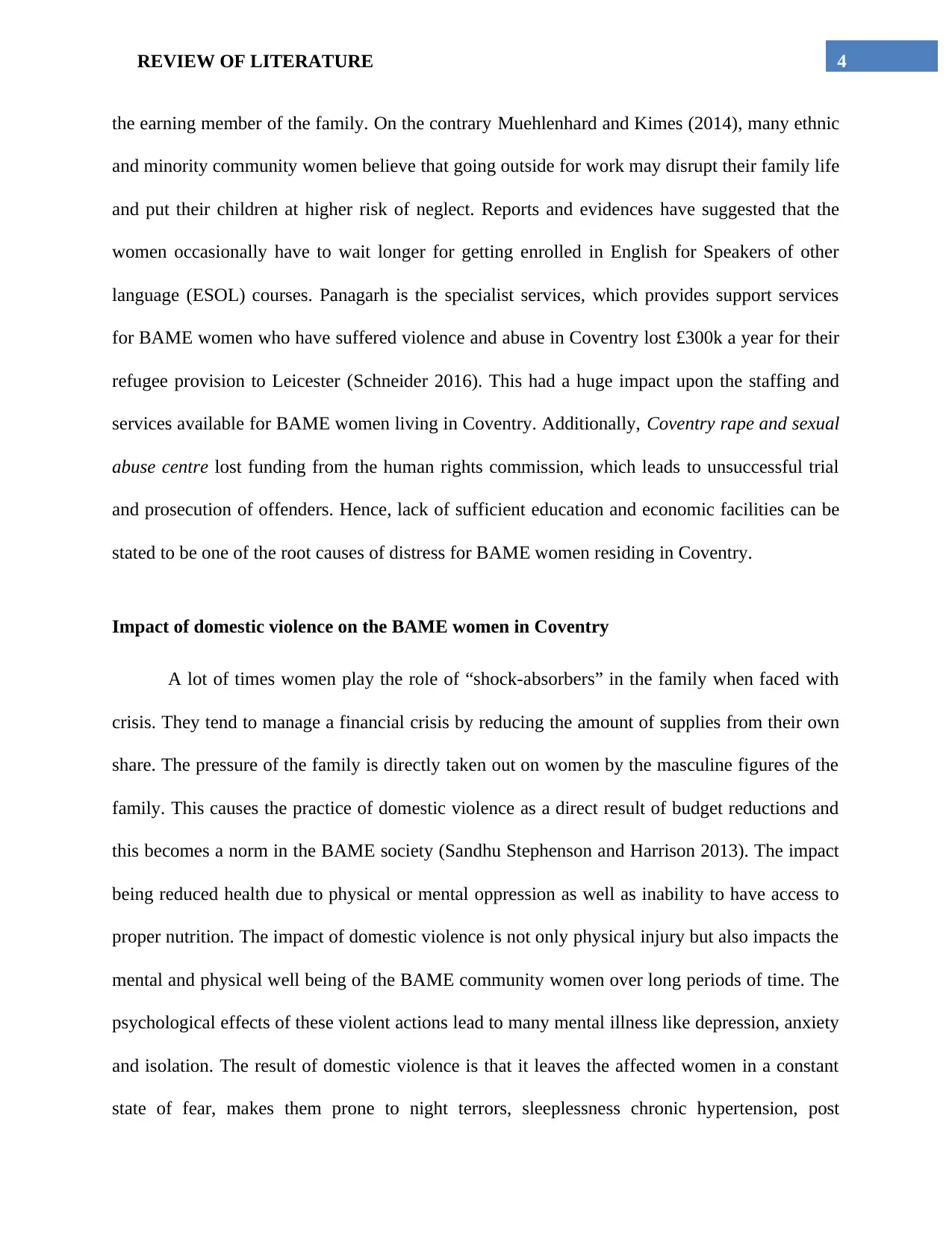
4REVIEW OF LITERATURE
the earning member of the family. On the contrary Muehlenhard and Kimes (2014), many ethnic
and minority community women believe that going outside for work may disrupt their family life
and put their children at higher risk of neglect. Reports and evidences have suggested that the
women occasionally have to wait longer for getting enrolled in English for Speakers of other
language (ESOL) courses. Panagarh is the specialist services, which provides support services
for BAME women who have suffered violence and abuse in Coventry lost £300k a year for their
refugee provision to Leicester (Schneider 2016). This had a huge impact upon the staffing and
services available for BAME women living in Coventry. Additionally, Coventry rape and sexual
abuse centre lost funding from the human rights commission, which leads to unsuccessful trial
and prosecution of offenders. Hence, lack of sufficient education and economic facilities can be
stated to be one of the root causes of distress for BAME women residing in Coventry.
Impact of domestic violence on the BAME women in Coventry
A lot of times women play the role of “shock-absorbers” in the family when faced with
crisis. They tend to manage a financial crisis by reducing the amount of supplies from their own
share. The pressure of the family is directly taken out on women by the masculine figures of the
family. This causes the practice of domestic violence as a direct result of budget reductions and
this becomes a norm in the BAME society (Sandhu Stephenson and Harrison 2013). The impact
being reduced health due to physical or mental oppression as well as inability to have access to
proper nutrition. The impact of domestic violence is not only physical injury but also impacts the
mental and physical well being of the BAME community women over long periods of time. The
psychological effects of these violent actions lead to many mental illness like depression, anxiety
and isolation. The result of domestic violence is that it leaves the affected women in a constant
state of fear, makes them prone to night terrors, sleeplessness chronic hypertension, post
the earning member of the family. On the contrary Muehlenhard and Kimes (2014), many ethnic
and minority community women believe that going outside for work may disrupt their family life
and put their children at higher risk of neglect. Reports and evidences have suggested that the
women occasionally have to wait longer for getting enrolled in English for Speakers of other
language (ESOL) courses. Panagarh is the specialist services, which provides support services
for BAME women who have suffered violence and abuse in Coventry lost £300k a year for their
refugee provision to Leicester (Schneider 2016). This had a huge impact upon the staffing and
services available for BAME women living in Coventry. Additionally, Coventry rape and sexual
abuse centre lost funding from the human rights commission, which leads to unsuccessful trial
and prosecution of offenders. Hence, lack of sufficient education and economic facilities can be
stated to be one of the root causes of distress for BAME women residing in Coventry.
Impact of domestic violence on the BAME women in Coventry
A lot of times women play the role of “shock-absorbers” in the family when faced with
crisis. They tend to manage a financial crisis by reducing the amount of supplies from their own
share. The pressure of the family is directly taken out on women by the masculine figures of the
family. This causes the practice of domestic violence as a direct result of budget reductions and
this becomes a norm in the BAME society (Sandhu Stephenson and Harrison 2013). The impact
being reduced health due to physical or mental oppression as well as inability to have access to
proper nutrition. The impact of domestic violence is not only physical injury but also impacts the
mental and physical well being of the BAME community women over long periods of time. The
psychological effects of these violent actions lead to many mental illness like depression, anxiety
and isolation. The result of domestic violence is that it leaves the affected women in a constant
state of fear, makes them prone to night terrors, sleeplessness chronic hypertension, post
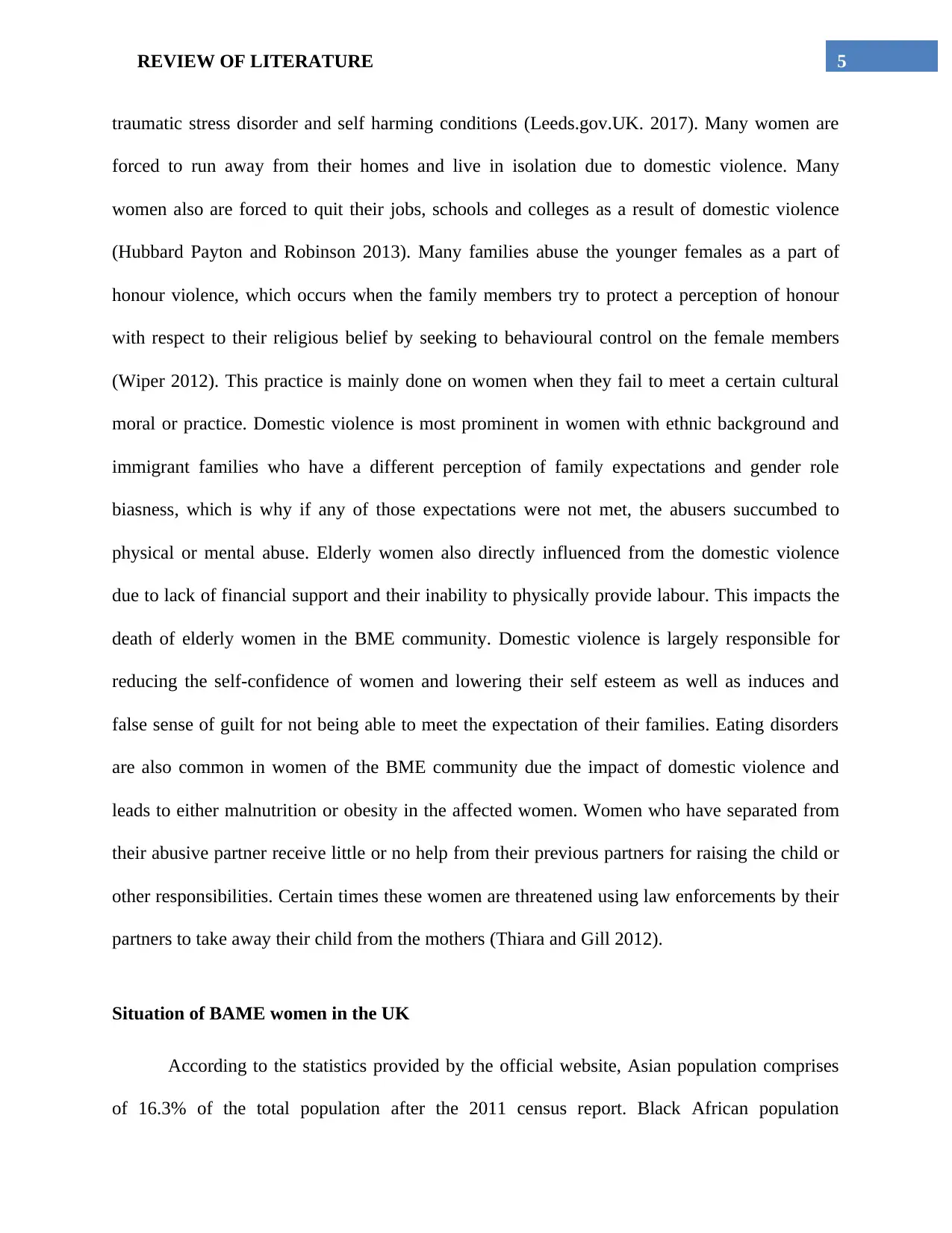
5REVIEW OF LITERATURE
traumatic stress disorder and self harming conditions (Leeds.gov.UK. 2017). Many women are
forced to run away from their homes and live in isolation due to domestic violence. Many
women also are forced to quit their jobs, schools and colleges as a result of domestic violence
(Hubbard Payton and Robinson 2013). Many families abuse the younger females as a part of
honour violence, which occurs when the family members try to protect a perception of honour
with respect to their religious belief by seeking to behavioural control on the female members
(Wiper 2012). This practice is mainly done on women when they fail to meet a certain cultural
moral or practice. Domestic violence is most prominent in women with ethnic background and
immigrant families who have a different perception of family expectations and gender role
biasness, which is why if any of those expectations were not met, the abusers succumbed to
physical or mental abuse. Elderly women also directly influenced from the domestic violence
due to lack of financial support and their inability to physically provide labour. This impacts the
death of elderly women in the BME community. Domestic violence is largely responsible for
reducing the self-confidence of women and lowering their self esteem as well as induces and
false sense of guilt for not being able to meet the expectation of their families. Eating disorders
are also common in women of the BME community due the impact of domestic violence and
leads to either malnutrition or obesity in the affected women. Women who have separated from
their abusive partner receive little or no help from their previous partners for raising the child or
other responsibilities. Certain times these women are threatened using law enforcements by their
partners to take away their child from the mothers (Thiara and Gill 2012).
Situation of BAME women in the UK
According to the statistics provided by the official website, Asian population comprises
of 16.3% of the total population after the 2011 census report. Black African population
traumatic stress disorder and self harming conditions (Leeds.gov.UK. 2017). Many women are
forced to run away from their homes and live in isolation due to domestic violence. Many
women also are forced to quit their jobs, schools and colleges as a result of domestic violence
(Hubbard Payton and Robinson 2013). Many families abuse the younger females as a part of
honour violence, which occurs when the family members try to protect a perception of honour
with respect to their religious belief by seeking to behavioural control on the female members
(Wiper 2012). This practice is mainly done on women when they fail to meet a certain cultural
moral or practice. Domestic violence is most prominent in women with ethnic background and
immigrant families who have a different perception of family expectations and gender role
biasness, which is why if any of those expectations were not met, the abusers succumbed to
physical or mental abuse. Elderly women also directly influenced from the domestic violence
due to lack of financial support and their inability to physically provide labour. This impacts the
death of elderly women in the BME community. Domestic violence is largely responsible for
reducing the self-confidence of women and lowering their self esteem as well as induces and
false sense of guilt for not being able to meet the expectation of their families. Eating disorders
are also common in women of the BME community due the impact of domestic violence and
leads to either malnutrition or obesity in the affected women. Women who have separated from
their abusive partner receive little or no help from their previous partners for raising the child or
other responsibilities. Certain times these women are threatened using law enforcements by their
partners to take away their child from the mothers (Thiara and Gill 2012).
Situation of BAME women in the UK
According to the statistics provided by the official website, Asian population comprises
of 16.3% of the total population after the 2011 census report. Black African population
⊘ This is a preview!⊘
Do you want full access?
Subscribe today to unlock all pages.

Trusted by 1+ million students worldwide
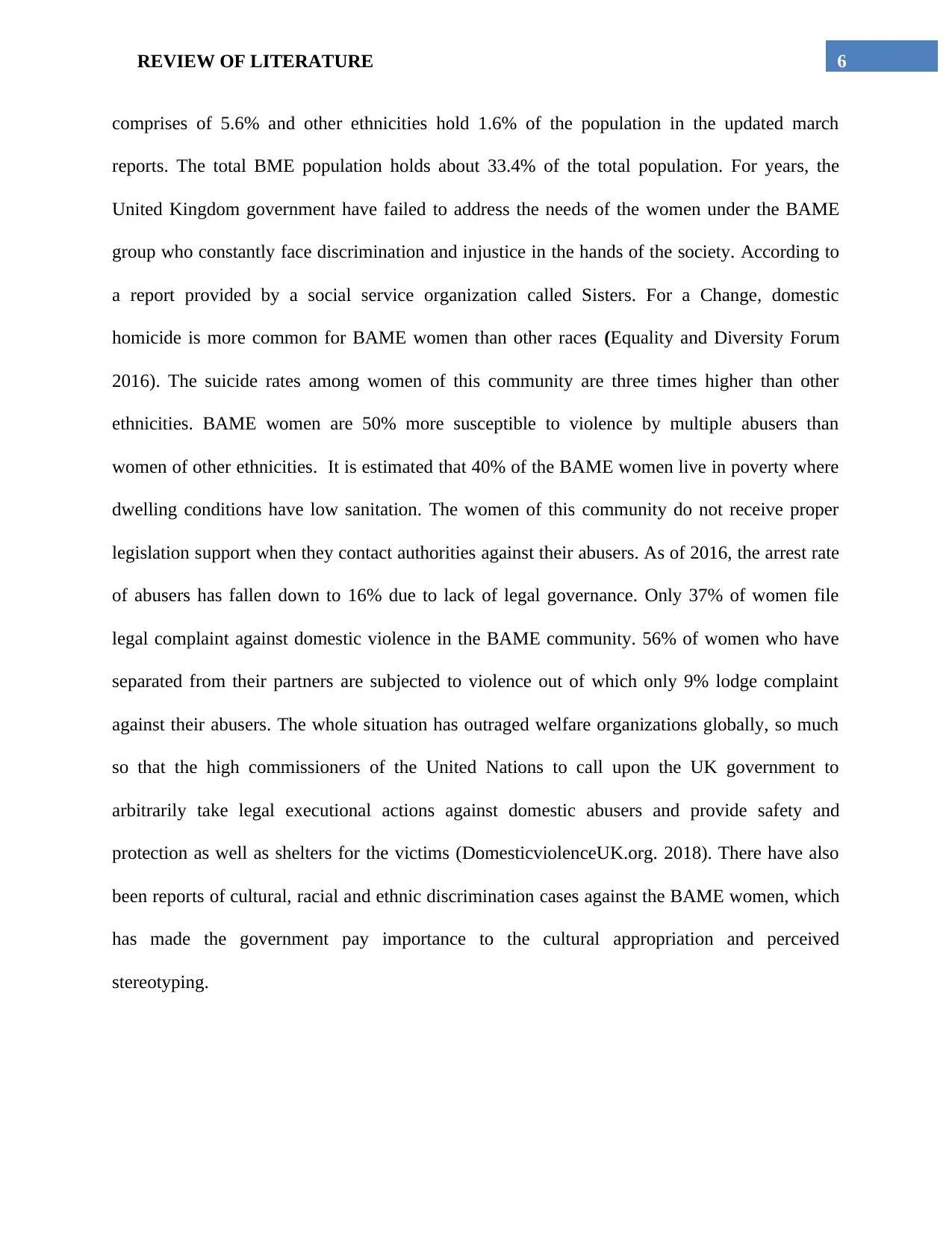
6REVIEW OF LITERATURE
comprises of 5.6% and other ethnicities hold 1.6% of the population in the updated march
reports. The total BME population holds about 33.4% of the total population. For years, the
United Kingdom government have failed to address the needs of the women under the BAME
group who constantly face discrimination and injustice in the hands of the society. According to
a report provided by a social service organization called Sisters. For a Change, domestic
homicide is more common for BAME women than other races (Equality and Diversity Forum
2016). The suicide rates among women of this community are three times higher than other
ethnicities. BAME women are 50% more susceptible to violence by multiple abusers than
women of other ethnicities. It is estimated that 40% of the BAME women live in poverty where
dwelling conditions have low sanitation. The women of this community do not receive proper
legislation support when they contact authorities against their abusers. As of 2016, the arrest rate
of abusers has fallen down to 16% due to lack of legal governance. Only 37% of women file
legal complaint against domestic violence in the BAME community. 56% of women who have
separated from their partners are subjected to violence out of which only 9% lodge complaint
against their abusers. The whole situation has outraged welfare organizations globally, so much
so that the high commissioners of the United Nations to call upon the UK government to
arbitrarily take legal executional actions against domestic abusers and provide safety and
protection as well as shelters for the victims (DomesticviolenceUK.org. 2018). There have also
been reports of cultural, racial and ethnic discrimination cases against the BAME women, which
has made the government pay importance to the cultural appropriation and perceived
stereotyping.
comprises of 5.6% and other ethnicities hold 1.6% of the population in the updated march
reports. The total BME population holds about 33.4% of the total population. For years, the
United Kingdom government have failed to address the needs of the women under the BAME
group who constantly face discrimination and injustice in the hands of the society. According to
a report provided by a social service organization called Sisters. For a Change, domestic
homicide is more common for BAME women than other races (Equality and Diversity Forum
2016). The suicide rates among women of this community are three times higher than other
ethnicities. BAME women are 50% more susceptible to violence by multiple abusers than
women of other ethnicities. It is estimated that 40% of the BAME women live in poverty where
dwelling conditions have low sanitation. The women of this community do not receive proper
legislation support when they contact authorities against their abusers. As of 2016, the arrest rate
of abusers has fallen down to 16% due to lack of legal governance. Only 37% of women file
legal complaint against domestic violence in the BAME community. 56% of women who have
separated from their partners are subjected to violence out of which only 9% lodge complaint
against their abusers. The whole situation has outraged welfare organizations globally, so much
so that the high commissioners of the United Nations to call upon the UK government to
arbitrarily take legal executional actions against domestic abusers and provide safety and
protection as well as shelters for the victims (DomesticviolenceUK.org. 2018). There have also
been reports of cultural, racial and ethnic discrimination cases against the BAME women, which
has made the government pay importance to the cultural appropriation and perceived
stereotyping.
Paraphrase This Document
Need a fresh take? Get an instant paraphrase of this document with our AI Paraphraser
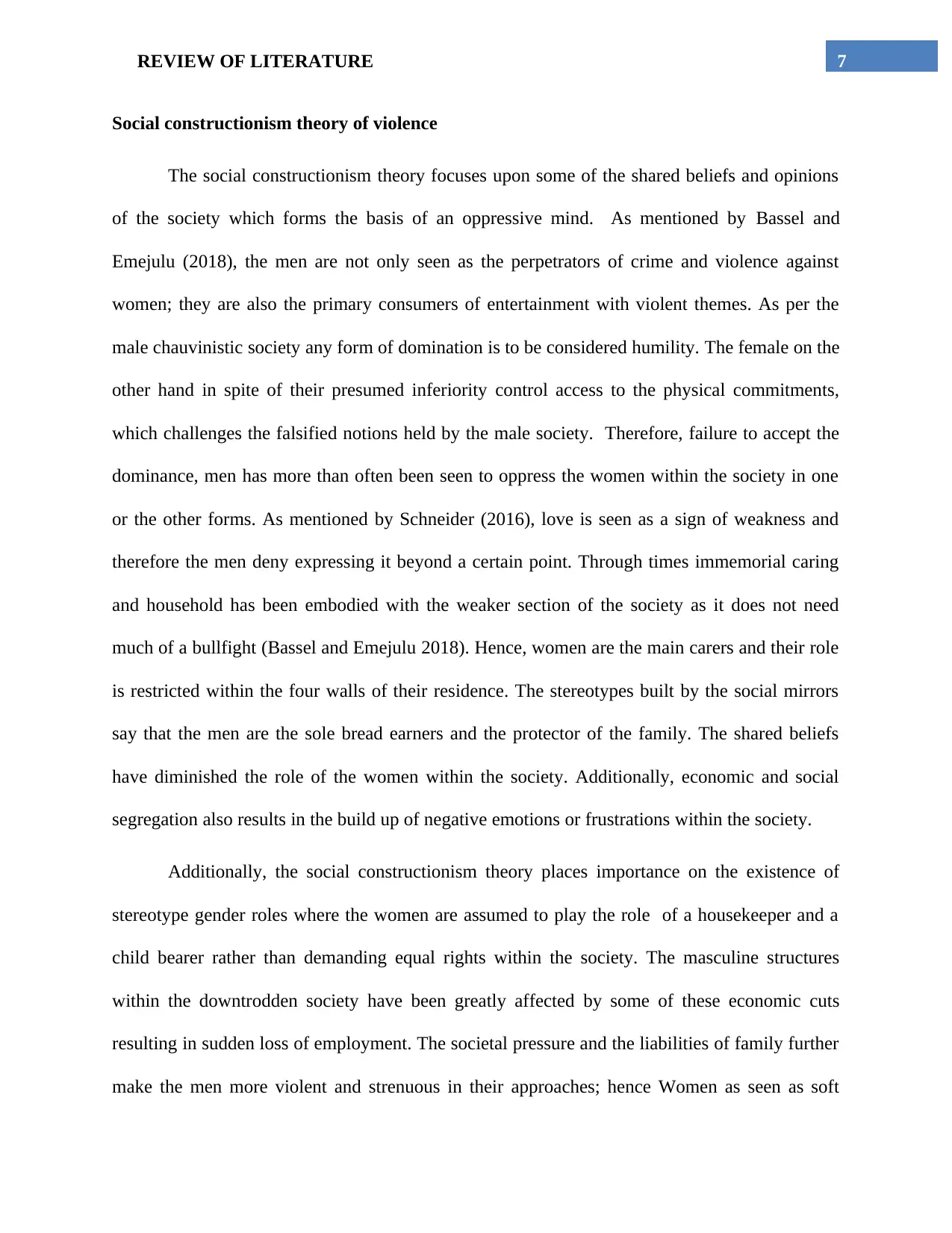
7REVIEW OF LITERATURE
Social constructionism theory of violence
The social constructionism theory focuses upon some of the shared beliefs and opinions
of the society which forms the basis of an oppressive mind. As mentioned by Bassel and
Emejulu (2018), the men are not only seen as the perpetrators of crime and violence against
women; they are also the primary consumers of entertainment with violent themes. As per the
male chauvinistic society any form of domination is to be considered humility. The female on the
other hand in spite of their presumed inferiority control access to the physical commitments,
which challenges the falsified notions held by the male society. Therefore, failure to accept the
dominance, men has more than often been seen to oppress the women within the society in one
or the other forms. As mentioned by Schneider (2016), love is seen as a sign of weakness and
therefore the men deny expressing it beyond a certain point. Through times immemorial caring
and household has been embodied with the weaker section of the society as it does not need
much of a bullfight (Bassel and Emejulu 2018). Hence, women are the main carers and their role
is restricted within the four walls of their residence. The stereotypes built by the social mirrors
say that the men are the sole bread earners and the protector of the family. The shared beliefs
have diminished the role of the women within the society. Additionally, economic and social
segregation also results in the build up of negative emotions or frustrations within the society.
Additionally, the social constructionism theory places importance on the existence of
stereotype gender roles where the women are assumed to play the role of a housekeeper and a
child bearer rather than demanding equal rights within the society. The masculine structures
within the downtrodden society have been greatly affected by some of these economic cuts
resulting in sudden loss of employment. The societal pressure and the liabilities of family further
make the men more violent and strenuous in their approaches; hence Women as seen as soft
Social constructionism theory of violence
The social constructionism theory focuses upon some of the shared beliefs and opinions
of the society which forms the basis of an oppressive mind. As mentioned by Bassel and
Emejulu (2018), the men are not only seen as the perpetrators of crime and violence against
women; they are also the primary consumers of entertainment with violent themes. As per the
male chauvinistic society any form of domination is to be considered humility. The female on the
other hand in spite of their presumed inferiority control access to the physical commitments,
which challenges the falsified notions held by the male society. Therefore, failure to accept the
dominance, men has more than often been seen to oppress the women within the society in one
or the other forms. As mentioned by Schneider (2016), love is seen as a sign of weakness and
therefore the men deny expressing it beyond a certain point. Through times immemorial caring
and household has been embodied with the weaker section of the society as it does not need
much of a bullfight (Bassel and Emejulu 2018). Hence, women are the main carers and their role
is restricted within the four walls of their residence. The stereotypes built by the social mirrors
say that the men are the sole bread earners and the protector of the family. The shared beliefs
have diminished the role of the women within the society. Additionally, economic and social
segregation also results in the build up of negative emotions or frustrations within the society.
Additionally, the social constructionism theory places importance on the existence of
stereotype gender roles where the women are assumed to play the role of a housekeeper and a
child bearer rather than demanding equal rights within the society. The masculine structures
within the downtrodden society have been greatly affected by some of these economic cuts
resulting in sudden loss of employment. The societal pressure and the liabilities of family further
make the men more violent and strenuous in their approaches; hence Women as seen as soft
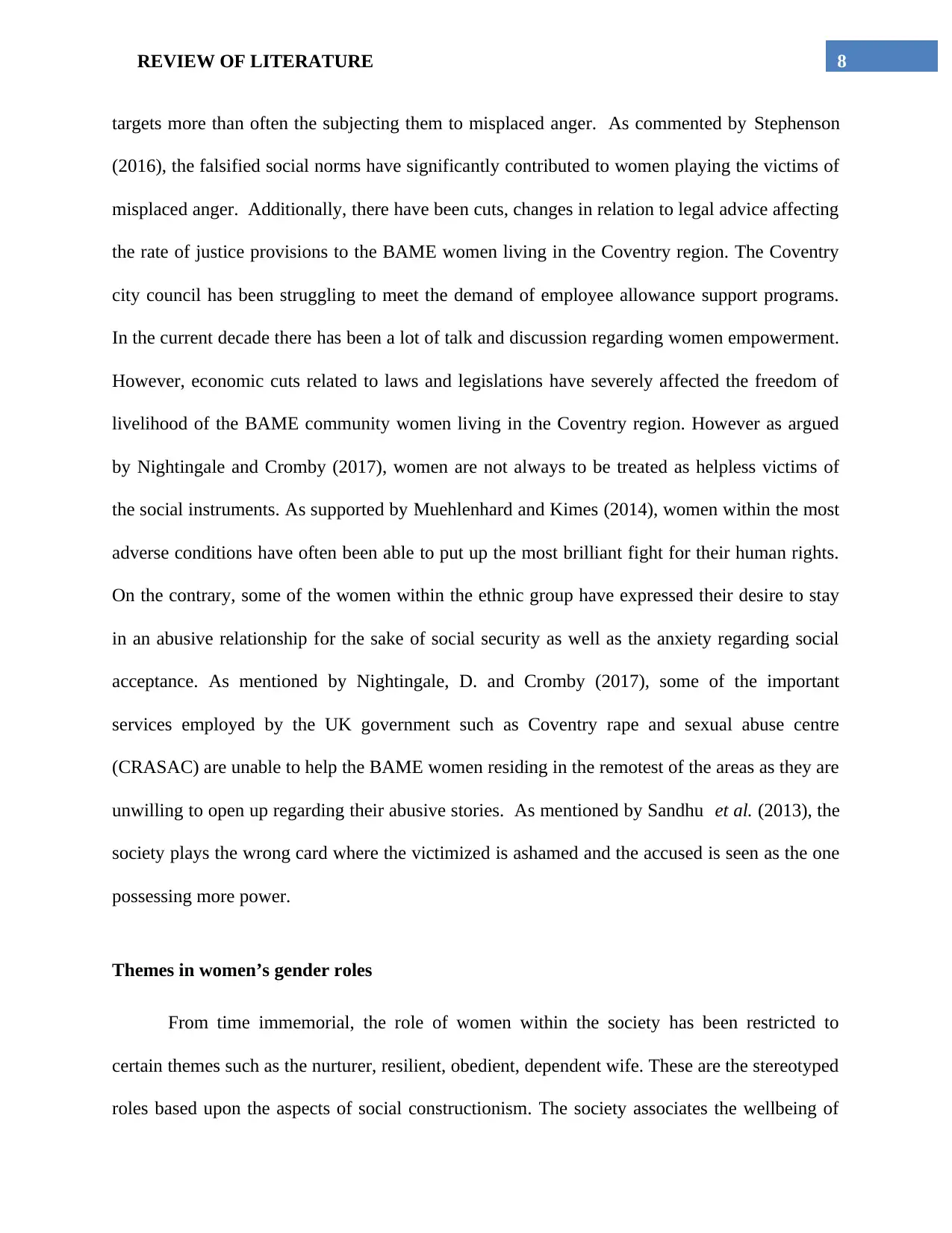
8REVIEW OF LITERATURE
targets more than often the subjecting them to misplaced anger. As commented by Stephenson
(2016), the falsified social norms have significantly contributed to women playing the victims of
misplaced anger. Additionally, there have been cuts, changes in relation to legal advice affecting
the rate of justice provisions to the BAME women living in the Coventry region. The Coventry
city council has been struggling to meet the demand of employee allowance support programs.
In the current decade there has been a lot of talk and discussion regarding women empowerment.
However, economic cuts related to laws and legislations have severely affected the freedom of
livelihood of the BAME community women living in the Coventry region. However as argued
by Nightingale and Cromby (2017), women are not always to be treated as helpless victims of
the social instruments. As supported by Muehlenhard and Kimes (2014), women within the most
adverse conditions have often been able to put up the most brilliant fight for their human rights.
On the contrary, some of the women within the ethnic group have expressed their desire to stay
in an abusive relationship for the sake of social security as well as the anxiety regarding social
acceptance. As mentioned by Nightingale, D. and Cromby (2017), some of the important
services employed by the UK government such as Coventry rape and sexual abuse centre
(CRASAC) are unable to help the BAME women residing in the remotest of the areas as they are
unwilling to open up regarding their abusive stories. As mentioned by Sandhu et al. (2013), the
society plays the wrong card where the victimized is ashamed and the accused is seen as the one
possessing more power.
Themes in women’s gender roles
From time immemorial, the role of women within the society has been restricted to
certain themes such as the nurturer, resilient, obedient, dependent wife. These are the stereotyped
roles based upon the aspects of social constructionism. The society associates the wellbeing of
targets more than often the subjecting them to misplaced anger. As commented by Stephenson
(2016), the falsified social norms have significantly contributed to women playing the victims of
misplaced anger. Additionally, there have been cuts, changes in relation to legal advice affecting
the rate of justice provisions to the BAME women living in the Coventry region. The Coventry
city council has been struggling to meet the demand of employee allowance support programs.
In the current decade there has been a lot of talk and discussion regarding women empowerment.
However, economic cuts related to laws and legislations have severely affected the freedom of
livelihood of the BAME community women living in the Coventry region. However as argued
by Nightingale and Cromby (2017), women are not always to be treated as helpless victims of
the social instruments. As supported by Muehlenhard and Kimes (2014), women within the most
adverse conditions have often been able to put up the most brilliant fight for their human rights.
On the contrary, some of the women within the ethnic group have expressed their desire to stay
in an abusive relationship for the sake of social security as well as the anxiety regarding social
acceptance. As mentioned by Nightingale, D. and Cromby (2017), some of the important
services employed by the UK government such as Coventry rape and sexual abuse centre
(CRASAC) are unable to help the BAME women residing in the remotest of the areas as they are
unwilling to open up regarding their abusive stories. As mentioned by Sandhu et al. (2013), the
society plays the wrong card where the victimized is ashamed and the accused is seen as the one
possessing more power.
Themes in women’s gender roles
From time immemorial, the role of women within the society has been restricted to
certain themes such as the nurturer, resilient, obedient, dependent wife. These are the stereotyped
roles based upon the aspects of social constructionism. The society associates the wellbeing of
⊘ This is a preview!⊘
Do you want full access?
Subscribe today to unlock all pages.

Trusted by 1+ million students worldwide
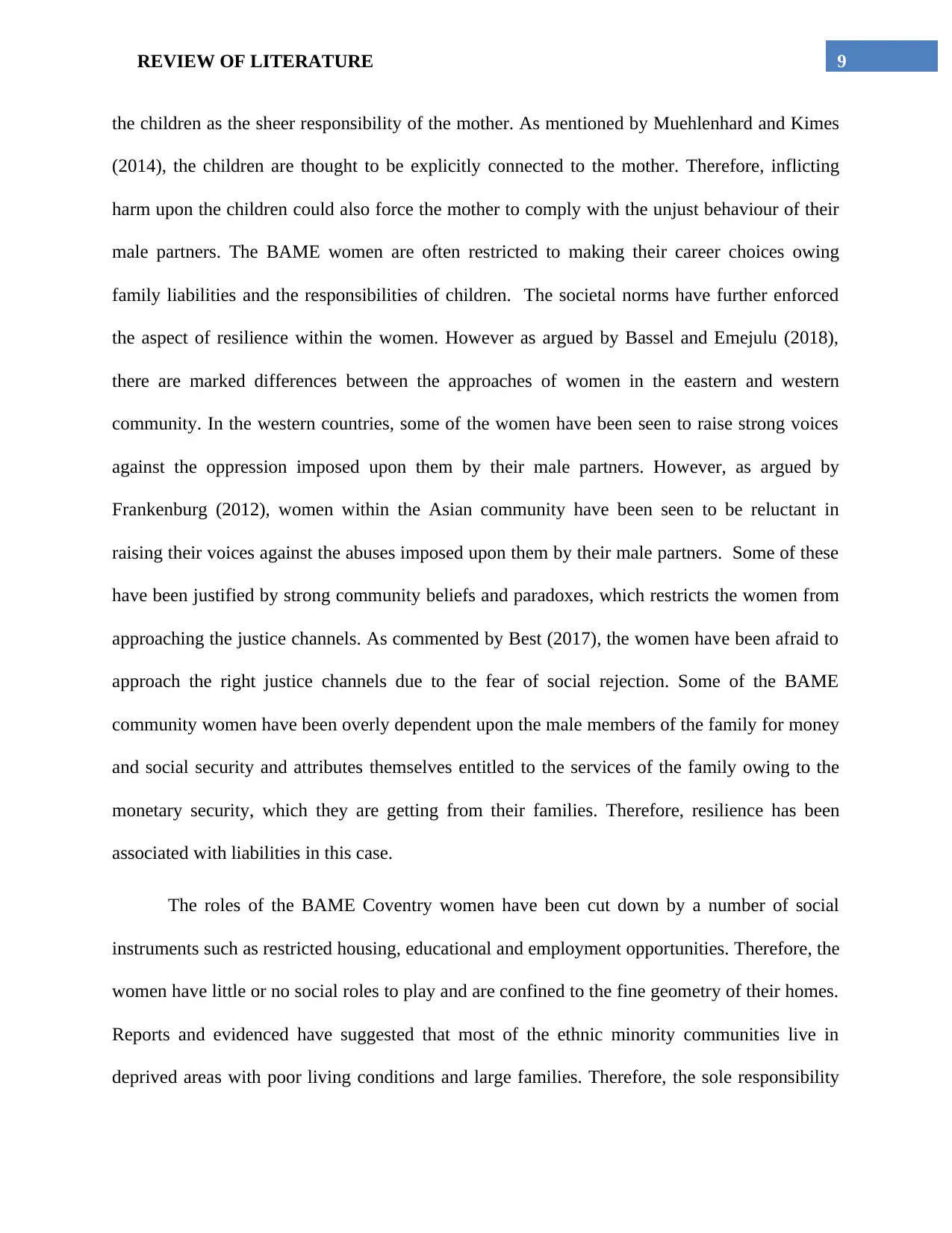
9REVIEW OF LITERATURE
the children as the sheer responsibility of the mother. As mentioned by Muehlenhard and Kimes
(2014), the children are thought to be explicitly connected to the mother. Therefore, inflicting
harm upon the children could also force the mother to comply with the unjust behaviour of their
male partners. The BAME women are often restricted to making their career choices owing
family liabilities and the responsibilities of children. The societal norms have further enforced
the aspect of resilience within the women. However as argued by Bassel and Emejulu (2018),
there are marked differences between the approaches of women in the eastern and western
community. In the western countries, some of the women have been seen to raise strong voices
against the oppression imposed upon them by their male partners. However, as argued by
Frankenburg (2012), women within the Asian community have been seen to be reluctant in
raising their voices against the abuses imposed upon them by their male partners. Some of these
have been justified by strong community beliefs and paradoxes, which restricts the women from
approaching the justice channels. As commented by Best (2017), the women have been afraid to
approach the right justice channels due to the fear of social rejection. Some of the BAME
community women have been overly dependent upon the male members of the family for money
and social security and attributes themselves entitled to the services of the family owing to the
monetary security, which they are getting from their families. Therefore, resilience has been
associated with liabilities in this case.
The roles of the BAME Coventry women have been cut down by a number of social
instruments such as restricted housing, educational and employment opportunities. Therefore, the
women have little or no social roles to play and are confined to the fine geometry of their homes.
Reports and evidenced have suggested that most of the ethnic minority communities live in
deprived areas with poor living conditions and large families. Therefore, the sole responsibility
the children as the sheer responsibility of the mother. As mentioned by Muehlenhard and Kimes
(2014), the children are thought to be explicitly connected to the mother. Therefore, inflicting
harm upon the children could also force the mother to comply with the unjust behaviour of their
male partners. The BAME women are often restricted to making their career choices owing
family liabilities and the responsibilities of children. The societal norms have further enforced
the aspect of resilience within the women. However as argued by Bassel and Emejulu (2018),
there are marked differences between the approaches of women in the eastern and western
community. In the western countries, some of the women have been seen to raise strong voices
against the oppression imposed upon them by their male partners. However, as argued by
Frankenburg (2012), women within the Asian community have been seen to be reluctant in
raising their voices against the abuses imposed upon them by their male partners. Some of these
have been justified by strong community beliefs and paradoxes, which restricts the women from
approaching the justice channels. As commented by Best (2017), the women have been afraid to
approach the right justice channels due to the fear of social rejection. Some of the BAME
community women have been overly dependent upon the male members of the family for money
and social security and attributes themselves entitled to the services of the family owing to the
monetary security, which they are getting from their families. Therefore, resilience has been
associated with liabilities in this case.
The roles of the BAME Coventry women have been cut down by a number of social
instruments such as restricted housing, educational and employment opportunities. Therefore, the
women have little or no social roles to play and are confined to the fine geometry of their homes.
Reports and evidenced have suggested that most of the ethnic minority communities live in
deprived areas with poor living conditions and large families. Therefore, the sole responsibility
Paraphrase This Document
Need a fresh take? Get an instant paraphrase of this document with our AI Paraphraser
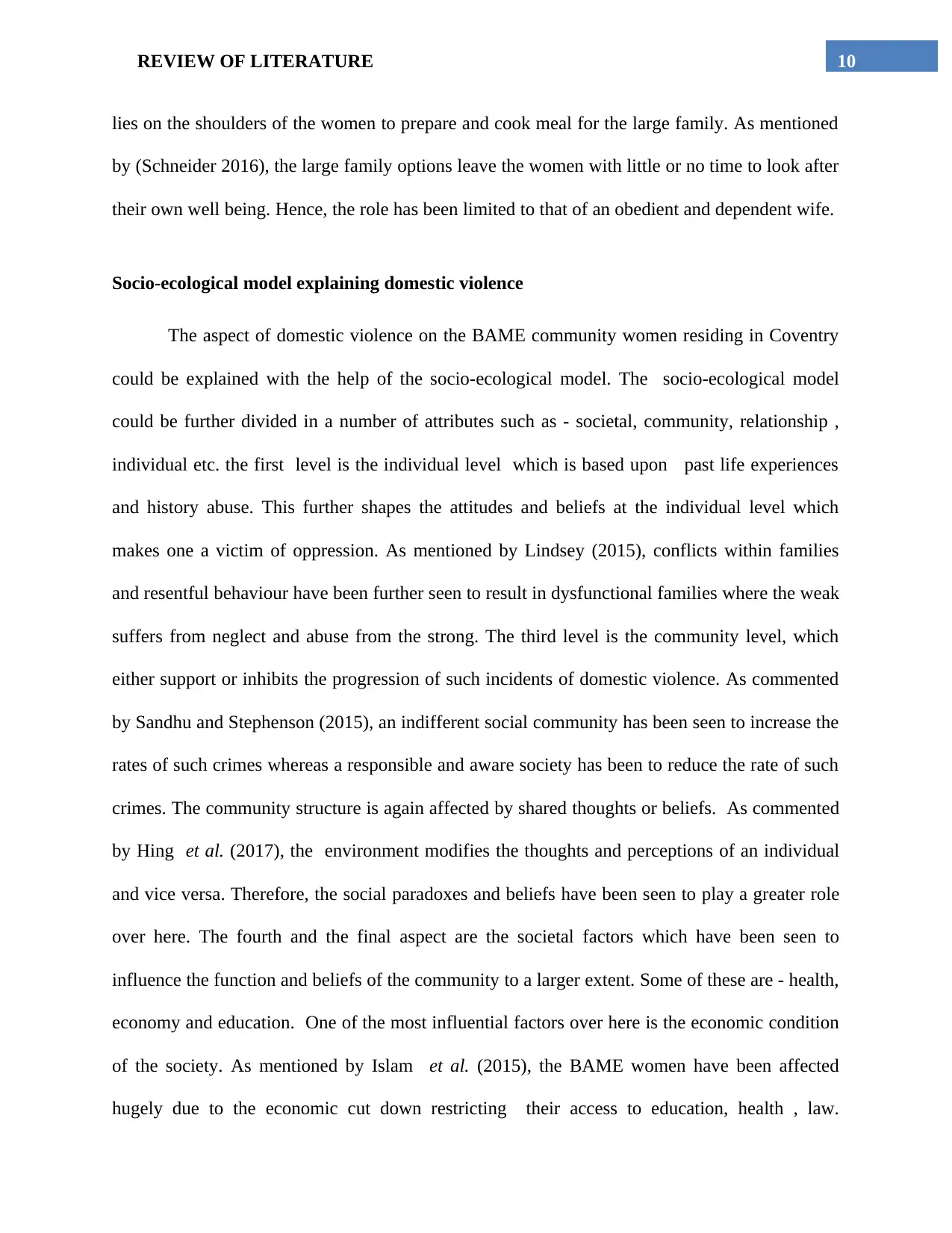
10REVIEW OF LITERATURE
lies on the shoulders of the women to prepare and cook meal for the large family. As mentioned
by (Schneider 2016), the large family options leave the women with little or no time to look after
their own well being. Hence, the role has been limited to that of an obedient and dependent wife.
Socio-ecological model explaining domestic violence
The aspect of domestic violence on the BAME community women residing in Coventry
could be explained with the help of the socio-ecological model. The socio-ecological model
could be further divided in a number of attributes such as - societal, community, relationship ,
individual etc. the first level is the individual level which is based upon past life experiences
and history abuse. This further shapes the attitudes and beliefs at the individual level which
makes one a victim of oppression. As mentioned by Lindsey (2015), conflicts within families
and resentful behaviour have been further seen to result in dysfunctional families where the weak
suffers from neglect and abuse from the strong. The third level is the community level, which
either support or inhibits the progression of such incidents of domestic violence. As commented
by Sandhu and Stephenson (2015), an indifferent social community has been seen to increase the
rates of such crimes whereas a responsible and aware society has been to reduce the rate of such
crimes. The community structure is again affected by shared thoughts or beliefs. As commented
by Hing et al. (2017), the environment modifies the thoughts and perceptions of an individual
and vice versa. Therefore, the social paradoxes and beliefs have been seen to play a greater role
over here. The fourth and the final aspect are the societal factors which have been seen to
influence the function and beliefs of the community to a larger extent. Some of these are - health,
economy and education. One of the most influential factors over here is the economic condition
of the society. As mentioned by Islam et al. (2015), the BAME women have been affected
hugely due to the economic cut down restricting their access to education, health , law.
lies on the shoulders of the women to prepare and cook meal for the large family. As mentioned
by (Schneider 2016), the large family options leave the women with little or no time to look after
their own well being. Hence, the role has been limited to that of an obedient and dependent wife.
Socio-ecological model explaining domestic violence
The aspect of domestic violence on the BAME community women residing in Coventry
could be explained with the help of the socio-ecological model. The socio-ecological model
could be further divided in a number of attributes such as - societal, community, relationship ,
individual etc. the first level is the individual level which is based upon past life experiences
and history abuse. This further shapes the attitudes and beliefs at the individual level which
makes one a victim of oppression. As mentioned by Lindsey (2015), conflicts within families
and resentful behaviour have been further seen to result in dysfunctional families where the weak
suffers from neglect and abuse from the strong. The third level is the community level, which
either support or inhibits the progression of such incidents of domestic violence. As commented
by Sandhu and Stephenson (2015), an indifferent social community has been seen to increase the
rates of such crimes whereas a responsible and aware society has been to reduce the rate of such
crimes. The community structure is again affected by shared thoughts or beliefs. As commented
by Hing et al. (2017), the environment modifies the thoughts and perceptions of an individual
and vice versa. Therefore, the social paradoxes and beliefs have been seen to play a greater role
over here. The fourth and the final aspect are the societal factors which have been seen to
influence the function and beliefs of the community to a larger extent. Some of these are - health,
economy and education. One of the most influential factors over here is the economic condition
of the society. As mentioned by Islam et al. (2015), the BAME women have been affected
hugely due to the economic cut down restricting their access to education, health , law.
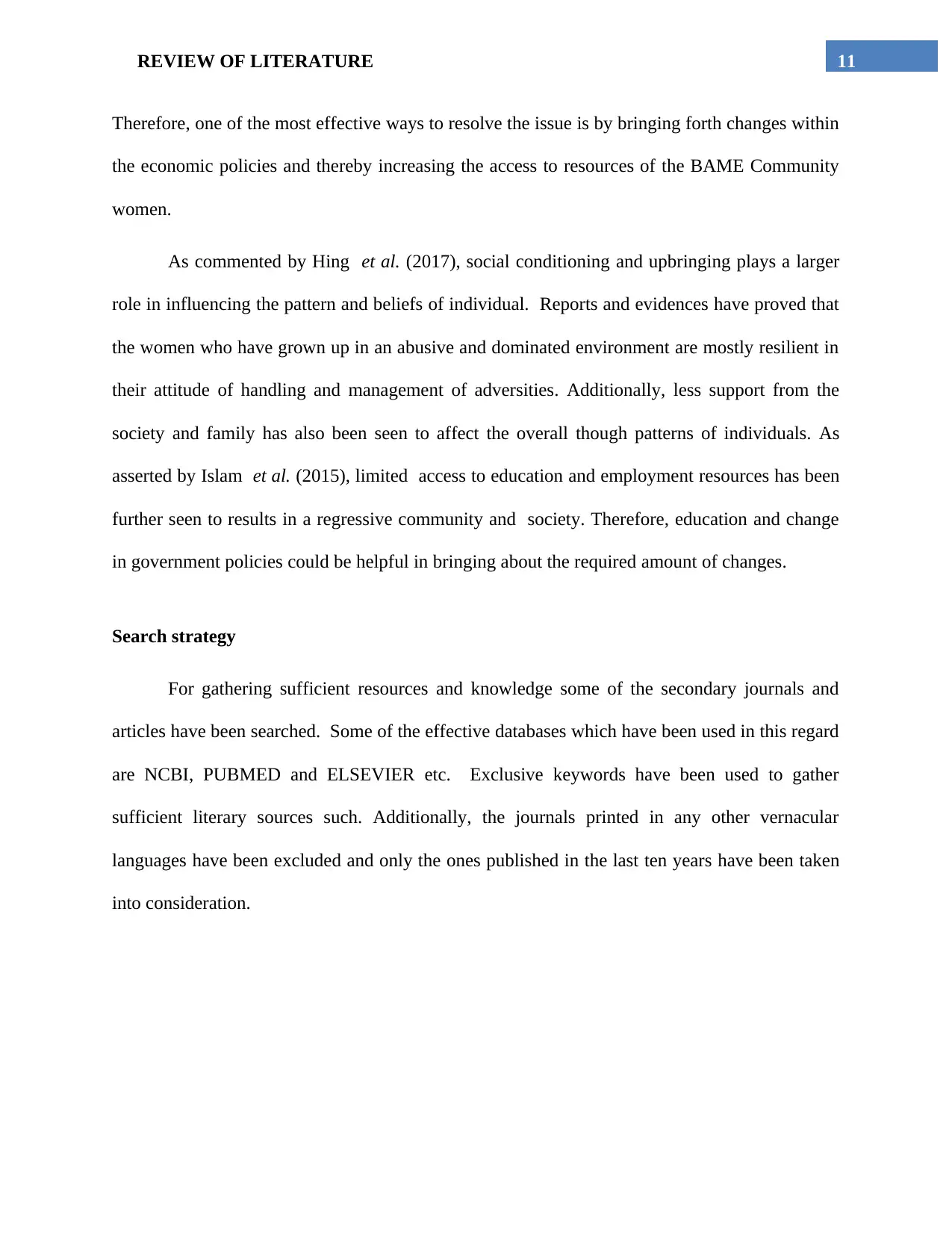
11REVIEW OF LITERATURE
Therefore, one of the most effective ways to resolve the issue is by bringing forth changes within
the economic policies and thereby increasing the access to resources of the BAME Community
women.
As commented by Hing et al. (2017), social conditioning and upbringing plays a larger
role in influencing the pattern and beliefs of individual. Reports and evidences have proved that
the women who have grown up in an abusive and dominated environment are mostly resilient in
their attitude of handling and management of adversities. Additionally, less support from the
society and family has also been seen to affect the overall though patterns of individuals. As
asserted by Islam et al. (2015), limited access to education and employment resources has been
further seen to results in a regressive community and society. Therefore, education and change
in government policies could be helpful in bringing about the required amount of changes.
Search strategy
For gathering sufficient resources and knowledge some of the secondary journals and
articles have been searched. Some of the effective databases which have been used in this regard
are NCBI, PUBMED and ELSEVIER etc. Exclusive keywords have been used to gather
sufficient literary sources such. Additionally, the journals printed in any other vernacular
languages have been excluded and only the ones published in the last ten years have been taken
into consideration.
Therefore, one of the most effective ways to resolve the issue is by bringing forth changes within
the economic policies and thereby increasing the access to resources of the BAME Community
women.
As commented by Hing et al. (2017), social conditioning and upbringing plays a larger
role in influencing the pattern and beliefs of individual. Reports and evidences have proved that
the women who have grown up in an abusive and dominated environment are mostly resilient in
their attitude of handling and management of adversities. Additionally, less support from the
society and family has also been seen to affect the overall though patterns of individuals. As
asserted by Islam et al. (2015), limited access to education and employment resources has been
further seen to results in a regressive community and society. Therefore, education and change
in government policies could be helpful in bringing about the required amount of changes.
Search strategy
For gathering sufficient resources and knowledge some of the secondary journals and
articles have been searched. Some of the effective databases which have been used in this regard
are NCBI, PUBMED and ELSEVIER etc. Exclusive keywords have been used to gather
sufficient literary sources such. Additionally, the journals printed in any other vernacular
languages have been excluded and only the ones published in the last ten years have been taken
into consideration.
⊘ This is a preview!⊘
Do you want full access?
Subscribe today to unlock all pages.

Trusted by 1+ million students worldwide
1 out of 25
Related Documents
Your All-in-One AI-Powered Toolkit for Academic Success.
+13062052269
info@desklib.com
Available 24*7 on WhatsApp / Email
![[object Object]](/_next/static/media/star-bottom.7253800d.svg)
Unlock your academic potential
Copyright © 2020–2025 A2Z Services. All Rights Reserved. Developed and managed by ZUCOL.




